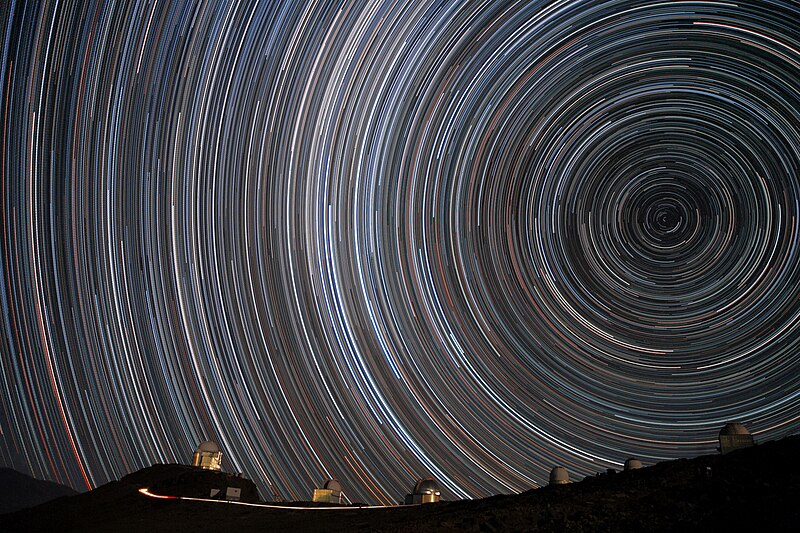File:Starry Spin-up.jpg

原始文件 (4,368 × 2,912像素,文件大小:5.35 MB,MIME类型:image/jpeg)
摘要
| 描述Starry Spin-up.jpg |
English: This image, taken by ESO Photo Ambassador Alexandre Santerne, is more than a little disorientating at first glance! Resembling an optical illusion or an abstract painting, the starry circles arc around the south celestial pole, seen overhead at ESO's La Silla Observatory in Chile.
Each circular streak represents an individual star, imaged over a long period of time to capture the motion of the stars across the sky caused by the Earth’s rotation. La Silla is based in the outskirts of Chile’s Atacama Desert at some 2400 metres above sea level, and offers perfect observing conditions for long-exposure shots like this; the site experiences over 300 clear nights a year! The site is host to many of ESO’s telescopes and to national projects run by the ESO Member States. Some of these telescopes can be seen towards the bottom of the image. The ESO 3.6-metre telescope stands tall on the left peak, now home to the world's foremost extrasolar planet hunter: the High Accuracy Radial velocity Planet Searcher (HARPS). Other telescopes at La Silla include the New Technology Telescope, which partly masks the ESO 3.6-metre telescope, Swiss 1.2-metre Leonhard Euler Telescope, ESO 1-metre Schmidt, the silver-domed MPG/ESO 2.2-metre, Danish 1.54-metre, and ESO 1.52-metre telescopes, which are visible here. Taking all these facilities together, La Silla is one of the most scientifically productive ground-based facilities in the world after ESO’s Very Large Telescope (VLT) observatory. With almost 300 refereed publications attributable to the work of the observatory per year, La Silla remains at the forefront of astronomy (ann15014). |
| 日期 | |
| 来源 | ESO/A.Santerne |
| 作者 | http://www.eso.org/public/images/potw1534a/ |
许可协议
 |
This media was created by the European Southern Observatory (ESO).
Their website states: "Unless specifically noted, the images, videos, and music distributed on the public ESO website, along with the texts of press releases, announcements, pictures of the week, blog posts and captions, are licensed under a Creative Commons Attribution 4.0 International License, and may on a non-exclusive basis be reproduced without fee provided the credit is clear and visible." To the uploader: You must provide a link (URL) to the original file and the authorship information if available. |
说明
此文件中描述的项目
描绘内容
知识共享署名4.0国际 简体中文(已转写)
24 8 2015
文件历史
点击某个日期/时间查看对应时刻的文件。
| 日期/时间 | 缩略图 | 大小 | 用户 | 备注 | |
|---|---|---|---|---|---|
| 当前 | 2024年2月14日 (三) 15:12 |  | 4,368 × 2,912(5.35 MB) | C messier | full size |
| 2015年8月24日 (一) 09:22 |  | 1,280 × 853(427 KB) | Jmencisom | User created page with UploadWizard |
文件用途
以下页面使用本文件:
全域文件用途
以下其他wiki使用此文件:
- en.wikipedia.org上的用途
- uk.wikipedia.org上的用途
元数据
此文件中包含有扩展的信息。这些信息可能是由数码相机或扫描仪在创建或数字化过程中所添加。
如果此文件的源文件已经被修改,一些信息在修改后的文件中将不能完全反映出来。
| 提供者 | ESO/A.Santerne |
|---|---|
| 来源 | European Southern Observatory |
| 简短标题 |
|
| 图像标题 |
|
| 使用条款 |
|
| 数据生成日期时间 | 2015年8月24日 (一) 10:00 |
| JPEG文件备注 | This image, taken by ESO Photo Ambassador Alexandre Santerne, is more than a little disorientating at first glance! Resembling an optical illusion or an abstract painting, the starry circles arc around the south celestial pole, seen overhead at ESO's La Silla Observatory in Chile. Each circular streak represents an individual star, imaged over a long period of time to capture the motion of the stars across the sky caused by the Earth’s rotation. La Silla is based in the outskirts of Chile’s Atacama Desert at some 2400 metres above sea level, and offers perfect observing conditions for long-exposure shots like this; the site experiences over 300 clear nights a year! The site is host to many of ESO’s telescopes and to national projects run by the ESO Member States. Some of these telescopes can be seen towards the bottom of the image. The ESO 3.6-metre telescope stands tall on the left peak, now home to the world's foremost extrasolar planet hunter: the High Accuracy Radial velocity Planet Searcher (HARPS). Other telescopes at La Silla include the New Technology Telescope, which partly masks the ESO 3.6-metre telescope, Swiss 1.2-metre Leonhard Euler Telescope, ESO 1-metre Schmidt, the silver-domed MPG/ESO 2.2-metre, Danish 1.54-metre, and ESO 1.52-metre telescopes, which are visible here. Taking all these facilities together, La Silla is one of the most scientifically productive ground-based facilities in the world after ESO’s Very Large Telescope (VLT) observatory. With almost 300 refereed publications attributable to the work of the observatory per year, La Silla remains at the forefront of astronomy (ann15014). Links: This photograph on Alexandre Santerne's Flickr photostream Alexandre Santerne’s Flickr photostream The “Your ESO Pictures” Flickr group |
| 关键词 | Star Trails |
| 联系信息 |
Karl-Schwarzschild-Strasse 2 Garching bei München, , D-85748 Germany |
| IIM版本 | 4 |

